Douglas Alpine Mattress: Cool Down Without Coils
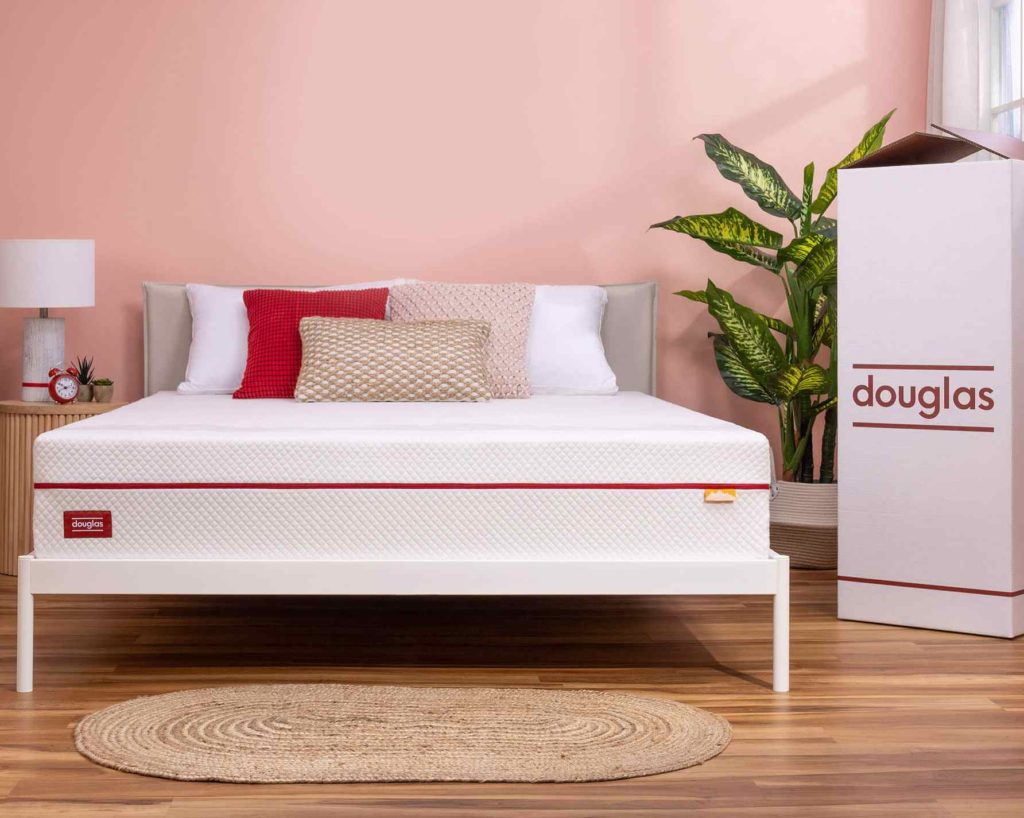
I tested and reviewed the Douglas Alpine Mattress to see if it really measured up to deliver cooling relief along with pressure and pain relief. The company sent me a sample and I was worried it might be cool and not comfortable, or hot and super pain relieving.
Made Locally In Canada By A Company I Trust
I’ve reviewed several mattresses made by Douglas Mattress, and when they asked me to review the Douglas Alpine Mattress, I wanted to compare it to other brands that really offer benefits for hot sleepers.
Our mattress survey has really made us aware of the vast number of people who sleep hot, often preventing them from getting deeper, restful sleep- even in cooler climates.
My test sample arrived perfectly packaged and sealed, and when I cut open the bag, the mattress unfurled and quickly rose to its original factory thickness of 11″ tall.
This is a pretty a typical height for an all foam mattress, and at 6’2″ tall and 190 lbs., I was kind of expecting to collapse and sink into the middle. Surprisingly though, even when on my side, I floated near the top, while my hips and shoulders immersed just a bit, without that unsteady wobbly feeling of being too firm.
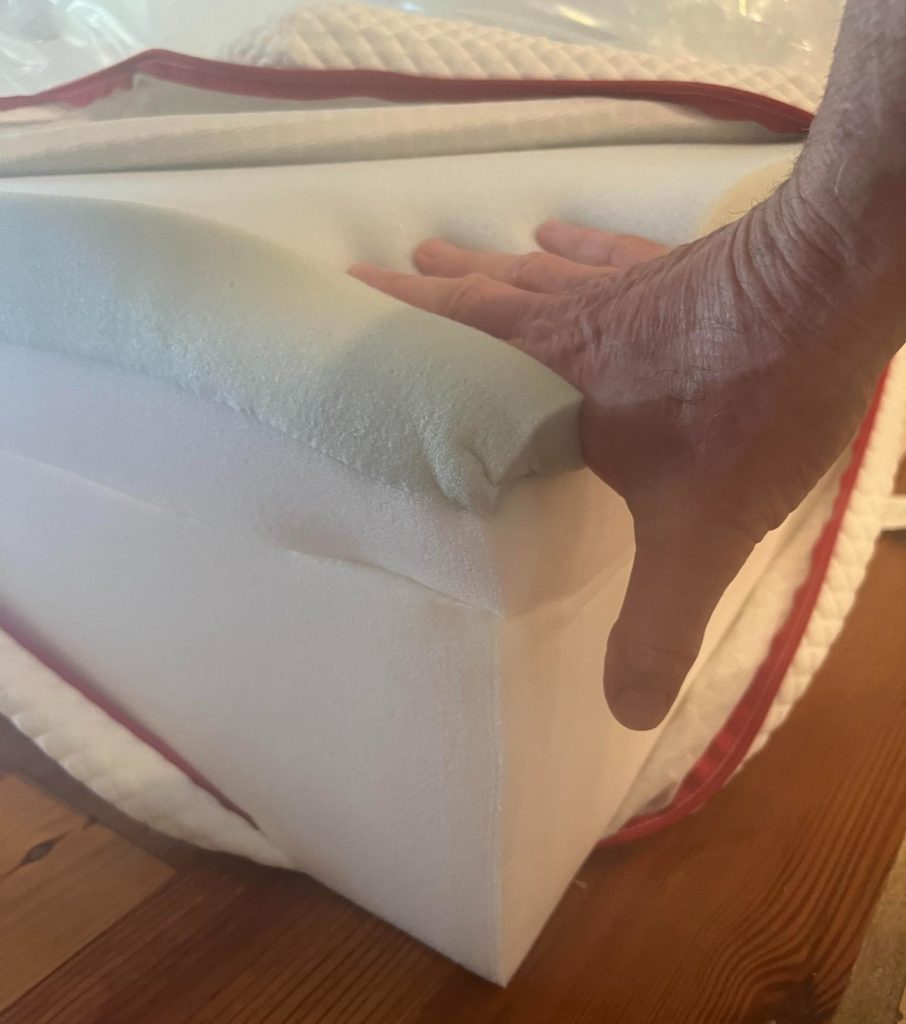
Great Support And Cooling Benefit Without Sinking In The Middle
We’ve surveyed our own readers about the best attributes their ideal mattress should have, and over 75% of them told us that sleeping hot keeps them from feeling restored and rested. Couples especially have difficulty with this issue, and The Douglas Alpine Mattress is strategically designed, without coils, to deliver on this chronic problem.
Let’s take a look at why this mattress, sold exclusively in Canada, not only can help with hot sleeping issues, but can also relieve pressure and pain as well.

I’m going to go into details about each layer below, but let’s talk about the overarching and immediate benefits you’ll get for this year round mattress option.
The manufacturer sent me a sample, eager for me to compare it to their original Douglas Mattress, which I’ve also reviewed on my Canada Mattress Page.
Priced At C$999 In Queen, And You Get 120 Days To Make Sure It Works For You
You might have tried memory foam or gel mattresses and found them to be somewhat effective, but if you want next level full-body support for all sleeping positions, I tested this options-totally made in Canada  – and urge you to try it out. Here’s what you’ll get…
– and urge you to try it out. Here’s what you’ll get…
- 11” height, 3 premium foam layers
- Cooling gel foam for a cooler sleep
- Polar® active temperature balancing
- 120-night sleep trial
- Effective motion isolation
- Support layers underneath that lift, not sink
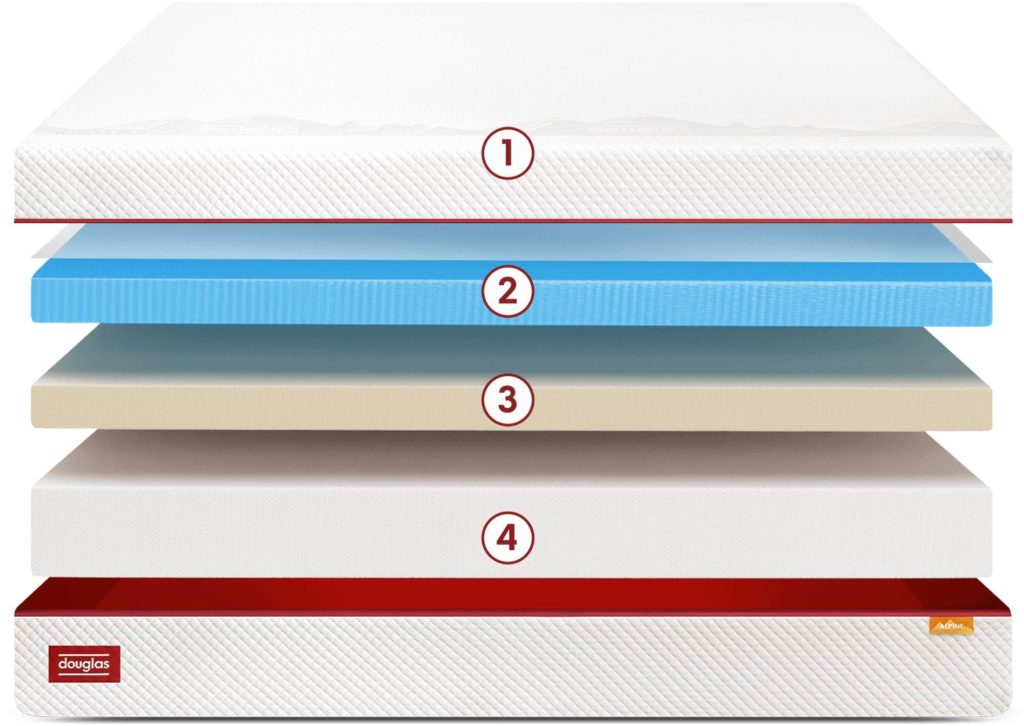
Three Layers Of Specialized Support
One asset I really like on any mattress is the ability to remove and wash the outer encasement. Of course, I always recommend using a mattress protector too, but in the event of a stain or an accident, washing the cover is essential.
The 2.25″ thick, blue layer of fused gel foam and memory foam is the engine of this mattress. Cooling gel foam and pressure relieving memory foam keeps you cool and pain free. If you want to learn more about how memory foam works, visit my memory foam page for lots of technical info.
You may have seen other mattresses sold online that offer so-called gel foam, and it’s usually made by adding “beads” that stretch within the layer of memory foam it’s infused in, basically a soupy kind of recipe that is not really that effective. In this case, The Douglas Alpine Mattress uses what is called “phase change” technology which actually reflects heat away, meaning to the sides, away from your body, and absorbs cool air from your surroundings.
In fact, when you lie down on it the first time, the sensation is kind of weird actually, almost feeling like you are instantly cooled down, though the feeling kind of balances out after a few minutes to a more cooling, neutral feel. They called this technology “Polar® temperature-balancing” and it seems to work.
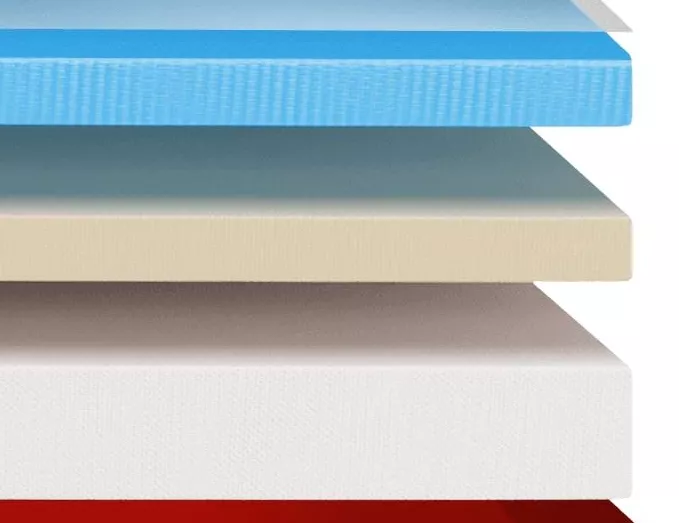
To help with motion transfer and support, beneath the blue phase change layer are two additional components that provide neutral buoyancy, motion transfer reduction, support, and just the right touch of bounce.
Believe it or not, bounciness is a critical part of an ideal “cake recipe” design for a mattress that will keep your spine straight and level in any position.
The creamy elastic response layer is 2.25″, and is situated on top of a 6.5″ layer of support foam that keeps you on top of your mattress, and eliminates bumps, shakes, and jiggles.
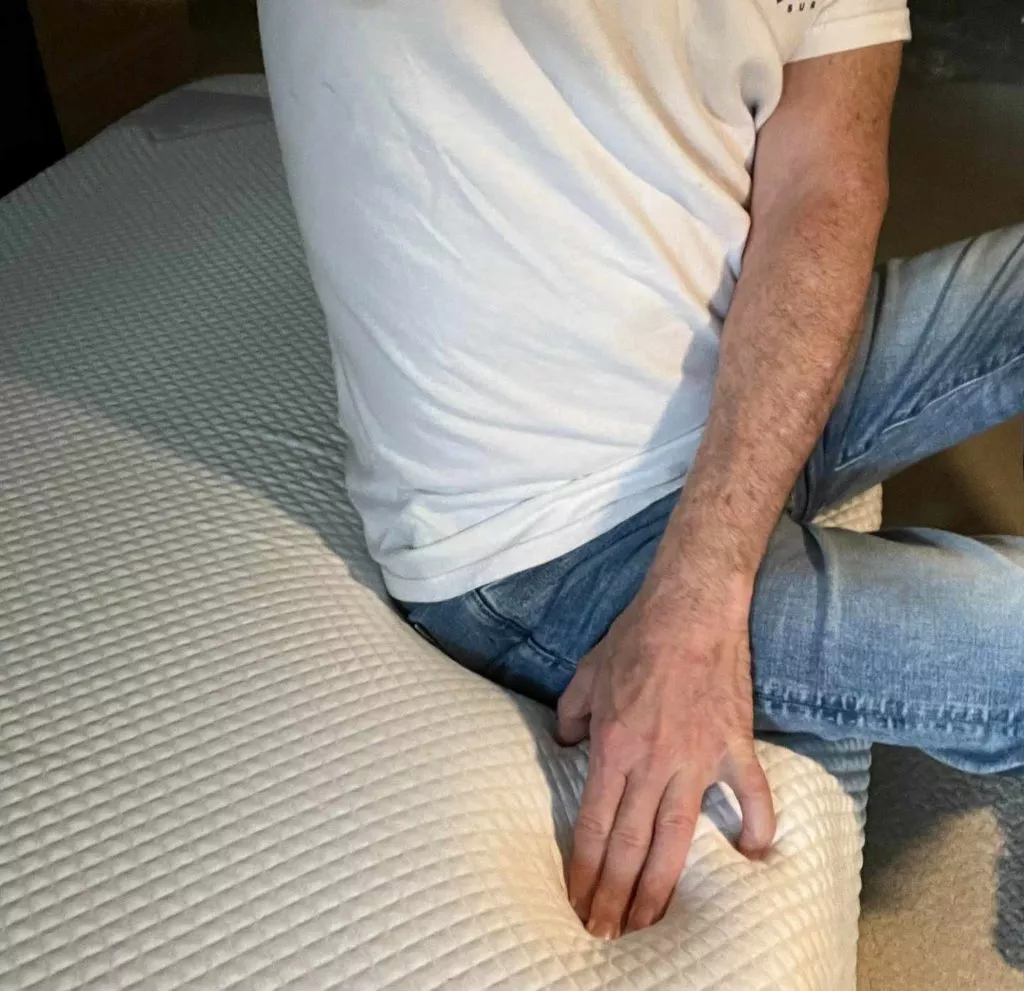
For comfort and support, the Douglas Alpine Cooling Mattress ranks at about a 6.5 if 10 were very firm and 1 were very soft, so it’s really comfortably firm, not mushy, making it easy to change positions effortlessly- without waking up.

With free shipping, free returns, a 120 night trial period, and a free mattress protector included, it’s my favorite cooling mattress in Canada! You can order through my link here to get the best deal.
Douglas Alpine Mattress: 10 Datapoint Test And Interpretations
| Test Point | Results | Score |
|---|---|---|
| 1. Comfort | Excellent (for up to 550 lbs. combined) | 9 |
| 2. Firmness | Comfortably firm, not spongy | 9 |
| 3. Pressure Relief | Great option for side sleepers | 9 |
| 4. Cooling | Excellent, sustained cooling | 9 |
| 5. Motion | Minimal- great for couples, up to 550 lb. (204kg) combined | 8 |
| 6. Turning | Excellent (esp. side to back) | 10 |
| 7. Edge | Very Good- for sitting and transfer, performed well | 10 |
| 8. Intimacy | Very Good-silk padded pillow top reduces motion transfer | 8 |
| 9. Value | Excellent- 20-30% less expensive than retail store luxury brands | 9 |
| 10. Odor | Very minimal- for few days, disappears quickly | 9 |
| Overall rating: 9 out of 10, Tested 2/18/23 |
- Comfort– This is partially a subjective test, but involves objective testing including depth of immersion at hips and shoulders. The Douglas Alpine Mattress is only available in one level of firmness, which I’d describe at about 6.5 out of 10, 10 being very firm (like a carpeted floor) and 1-2 being soft and excessively spongy. I am 6’1″ and 188lbs, and immersed only about 2.5″ at hips and shoulders while on my side. Rating For This Variable: 9
- Firmness- I included this parameter in the test because the mattress is only available in one firmness option. My perception is that it is medium firm and comfortable for most people, including couples weighing up to 550 lbs. combined weight. Rating For This Variable: 9
- Pressure Relief– The 11″ tall Douglas Alpine Mattress has a quilted pillow top piece that contains a 2.25-inch gel foam comfort layer that spreads out weight, a 2.25-inch Elastex polyfoam transitional layer, and a 6.5-inch high-density polyfoam support core. There is no coil section in this mattress, so it is not as bouncy, with about 50% less response time than a hybrid mattress which incorporates foam along with a pocketed coil layer. Rating For This Variable: 9
- Cooling- Using my digital probes inserted 2″ from the top edge of The Douglas Alpine Mattress, I tested the the surface temperature before lying down in a room that was cooled to 74°F. Initial temperature reading was 73°F, temperature probe was replaced in the same spot after 30 minutes of lying flat. Temperature had risen to 84°F, substantially lower than body temperature of 98.4°F Rating For This Variable: 9
- Motion Transfer- I gave The Douglas Alpine Mattress an 8 out of 10 for this variable as I found it to be not quite as “taught” as a hybrid mattress with coils, which makes it easy to turn without energetic movements. As an all foam mattress, it offers very good motion transfer dampening but only about 80% as efficiently as a mattress containing at least a 6″-8″ pocket coil component.
- Ease Of Turning: The Douglas Alpine Mattress, despite being all foam, had little sink (2.5″ at hips, 2.0″ at shoulders, so turning was completely effortless. I tried it with couples who snuggle in the middle, and although they experienced more full body sinking, turning was still very easy. I scored this variable at 10 out of 10.
- Edge Support: Because the high density foam layer at the bottom, which is 6″ thick, is a polyurethane foam with an ILD of 32, being quite firm compare to tother foam mattress construction. This allows a higher load while seated at the edge of the mattress and provide for less sinking and reduced chance of sliding off. I rated this variable at 10 out of 10.
- Intimacy: Snuggling and closeness ratings seemed very good by several couples who napped in the middle, not perfect, as one or two mentioned that the firmness wasn’t as “bouncy” as they would have preferred. I rated this variable at 8 out of 10.
- Value: The Douglas Alpine Mattress sells for C$999 in queen and C$1299 in king, still $500 less than the Casper Original which is a comparable brand. The Casper product does not offer a cooling layer of gel foam. The 13″ Tempur-Breeze® made by Tempur-Pedic® sells for $4599 in queen and $5299 in king. I have tested the Breeze personally and while it is astounding as far as its cooling ability (especially the initial feel), The Douglas Alpine appears to be 85% as cool to the touch as the Breeze (this is educated subjective estimate). I scored this variable at a 9 out of 10.
- Odor: At time of unpacking, there was a slight, pleasant “baked goods” odor to The Douglas Alpine Mattress, which was completely gone after 48 hours. I scored this variable at a 9 out of 10.
The Douglas Alpine Mattress: How Cooling Gel Foams Work
Oddly Cool To The Touch- How Do They Do That? A Scientific Explanation
To explain why The Douglas Alpine Mattress feels cold to the touch, it’s worth explaining just how the technology works. I’ve worked with temperature reactive foams and textiles for years, and the advent with the first “cooling mattresses” was interesting.
When you touch the top of a cooling mattress you might feel a cold sensation, and when you lie down, even for extended periods of time, that cool sensation doesn’t easily disappear. The Douglas Alpine Mattress incorporates this technology, called “phase change”.
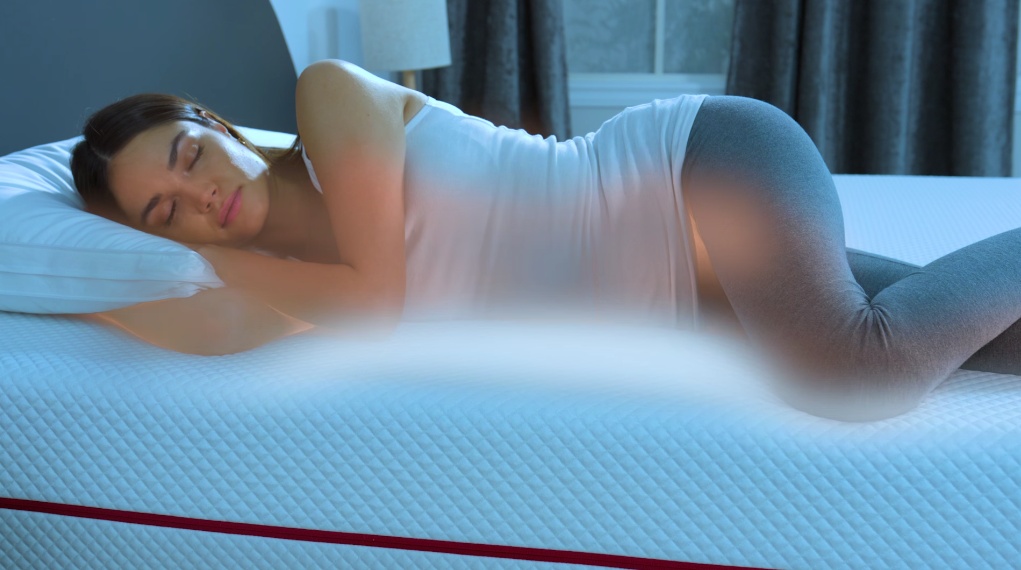
Phase change technology involves the use of materials known as phase change materials (PCMs), which have the ability to store and release thermal energy as they change from one phase (solid, liquid, or gas) to another, typically between solid and liquid states. This property allows PCMs to effectively regulate temperature by absorbing heat when they melt and releasing it when they solidify.
In the context of mattresses, phase change technology can be integrated into cooling foams to enhance their cooling ability.
Basically, the materials convert your body heat- into cold thermal energy. They are referred to as “PCM’s”, or phase change materials.
- Temperature Regulation: PCMs are incorporated into foam layers in the form of microcapsules or coatings. These PCMs are carefully selected to have melting points within a specific temperature range, typically corresponding to the body’s natural temperature fluctuations during sleep. For instance, they may melt when the mattress surface becomes too warm due to body heat and solidify when the temperature decreases.
- Heat Absorption: When the body releases heat during sleep, the PCM absorbs this excess heat as it changes from solid to liquid phase. This absorption process helps to prevent the mattress from becoming uncomfortably warm, thus maintaining a cooler sleeping surface.
- Heat Release: Conversely, when the body temperature decreases or the surrounding environment cools down, the PCM releases the stored heat as it changes back from liquid to solid phase. This release of heat helps to provide warmth and prevent the mattress from feeling too cold.
- Continuous Cooling: Unlike traditional cooling materials that may lose their cooling properties over time, PCMs offer continuous cooling throughout the night. As the PCM cycles between solid and liquid phases, it continually absorbs and releases heat, ensuring a consistent and comfortable sleep environment.
- Customization: Manufacturers can tailor the PCM properties, such as melting point and heat storage capacity, to suit different preferences and sleeping conditions. This customization allows for mattresses that provide optimal cooling comfort for a wide range of individuals.
Overall, by harnessing the power of phase change technology, mattresses can offer enhanced cooling capabilities, promoting better sleep quality and comfort for users. Whether you’re a hot sleeper or simply seeking a more refreshing sleep experience, PCM-infused cooling foams represent a cutting-edge solution to temperature regulation in mattresses.